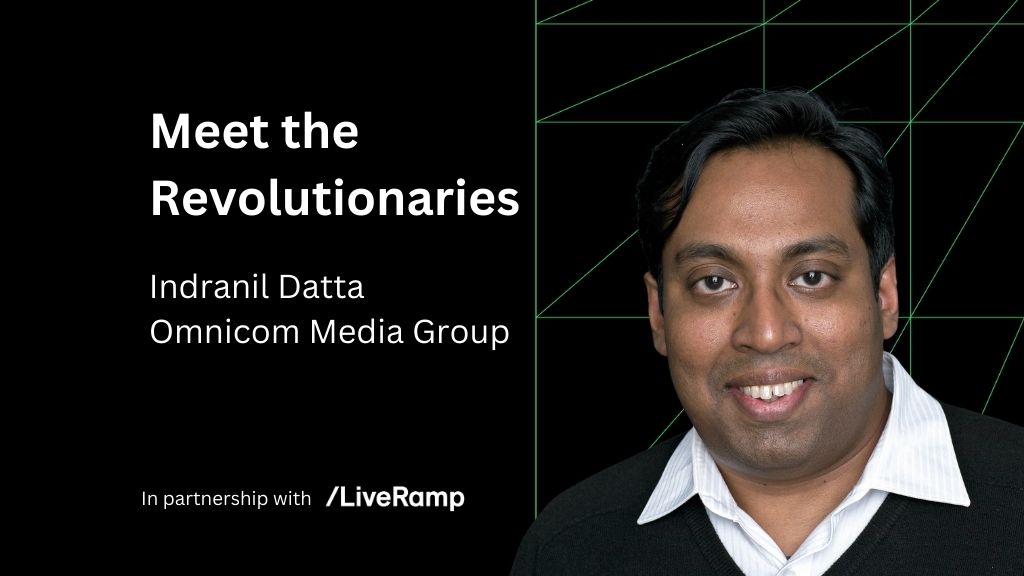New Digital Age (NDA) in association with LiveRamp is spotlighting the men and women championing a data-led revolution in the marketing industry. ‘Meet the Revolutionaries’ focuses on the efforts of the industry executives helping to push digital marketing into a new era of data collaboration.
Here, Indranil Datta, Head of Data and Technology Solutions at Annalect (the data agency of Omnicom Media Group) explains why data collaboration and hyper-personalisation are important to the future of marketing…
Tell me about your current role.
I head up our client-facing data and tech solutions function, specifically relating to media and marketing.
We provide a continuum of solutions. In the first instance, we consult with our clients on data and technology topics and strategy. We help them make sense of current and upcoming data and technology investment and to create a roadmap forward for their organisation.
We don’t stop at strategy though, we also consult and work closely with clients on implementation of new platforms and technologies. My team specialises in tech such as data clean rooms and customer data platforms. We see these technologies working in collaboration to bring the full spectrum of data value to our media and marketing clients.
Finally, when you’re working with multiple tech platforms, interoperability can become an issue. Sometimes there is a ‘last mile’ custom engineering solution required to bring multiple platforms together. So I have a small team that actually does that, builds those pipeline integrations, smoothing off the edges where multiple different platforms come together.
Can you give an example of a time when you personally helped to drive innovation?
My whole role is to drive innovation. My team operates at the cutting-edge of whatever modern marketers are trying to do with data and technology.
For the last 10 years or so, my career has taken a trajectory where I have been at the centre of innovative thinking. Back in 2010 for example, I was already talking to colleagues about using first-party data as a way to serve targeted advertising. We were also one of the first movers into ad verification. My team is one of the first teams to deploy enterprise scale data mesh into marketing.
Today, most of my clients are in a variety of sectors, such as Automotive, CPGs, Beverages, Gaming and Entertainment. All of these different categories have data challenges that are very specific to their particular domains.
A lot of my conversations with clients focus on how we can put data at the centre of their media and marketing strategies and how can we use other unusual data signals that we’re not currently considering? Things like stock depletion or geographical data. How can we bring multiple insights together to create a richer view of the customer and support better targeting?
What are the most common challenges to innovation?
This is a very good question, which I’d like to answer in two parts. There are organisational challenges, but also there are challenges at the level of individuals.
Organisations, especially larger organisations, have an in-built inertia, a resistance to change. Processes set in place, but innovation is about looking at things in a different way. It’s not usually about incremental benefit; it’s normally something that requires a step change in both people and process. I would say that 80% of the effort in my work is in changing people and processes, rather than dealing with the actual data and technology.
Innovation is also easier when there is a long term strategy. If you don’t have a strong foundation of strategy and stakeholder buy-in, innovation cannot survive. A good example is Generative AI solution. Everybody is talking about it, but without the foundation of clean, taxonomized data, you won’t be able to train your AI models. These strong foundations can’t be laid without support of a long-term data strategy.
In terms of individual personalities, it’s about being comfortable with discomfort. I believe the best place for a person to grow is when they are right at the cusp of comfort and discomfort. People who are too comfortable or too set in their ways are creating resistance to innovation and change in their minds. For innovation to happen, we need to constantly push ourselves to be on the edge of discomfort.
What tips can you offer others hoping to drive innovation?
I think of innovation as an outlook or mindset. It’s hunger to do more and not be content with the way things are right now. Are we constantly questioning ourselves if there a better way of doing things?
Cultivating that attitude, that hunger for excellence, within the team is very important to me. Innovation isn’t something you can really plan for. Good ideas don’t arrive to a particular schedule. It’s more of a people development issue, in my opinion. Hire really good people. Give them space to be able to challenge themselves and be proud of what they do. When you put those people together, the ideas start to emerge.
The other important duty that I feel I have as a department head, is to take away the fear of failure from my team members. Right? When I was small, my dad told me that throughout my life, I would make many mistakes. “My job,” he said, “is to not stop you from making those mistakes, it’s to make sure you know that, whatever happens, I’m with you.” That stuck with me and I try to drive innovation in a similar way.
How do you think digital marketing might evolve over the next few years?
One thing that’s very clear is that everybody’s talking about hyper-personalization. We have the tools to make it happen. We can already see a lot of different brands doing a lot of great omnichannel work. So, I think we’ll see hyper-personalization become mainstream.
The sort of short form videos that we see on TikTok or Instagram Reels will continue to dominate feeds. Content creators are industrialising the generation of these videos using GenAI. So we’re going to see content fatigue very soon, and a demand for genuine, meaningful content will emerge.
We’ll see a lot of different changes in digital marketing. There is a space for a few innovative companies who will allow consumers to invest and control their digital identity, because a lot of this personalisation depends on data and identity at scale.
We need to give that power and that education to the consumer. We need to explain that your digital identity and your online behaviour is valuable and that it can be leveraged to your advantage. So, I expect to see a rise of consumer focused identity solutions that will help to bring all of these things together.
Do you think ‘data collaboration’ will become more important to marketers?
It’s a lot easier now than it was before. The new breed of technologies, data clean rooms and data collaboration platforms, make it really easy to utilise and combine multiple data sets in a very secure way. We are right at the heart of delivering many of these projects, so the value is very clear to us.
The technology has almost ‘leap-frogged’ the people and process aspect of it. Marketers are at a point where, first of all, they really understand the value of data. Some brands have also come to the realisation that they cannot get the lift they need and create the one-to-one interaction with the consumer they want on their own. They need to collaborate with other data providers to create consortiums of consumers that they can all talk to, for their mutual benefit.
The most important challenge that remains is the conversation that needs to take place between the marketer in a brand and their Data Protection Officer, because they usually live in two different worlds. The DPO’s job is to keep the brand safe from potential risk of privacy breaches, so they need to understand what data collaboration involves and any risk it might pose. I think that’s a conversation most brands will need to have imminently.












